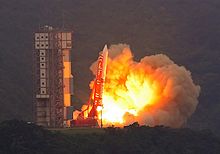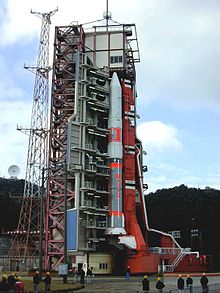M-V
 The fifth M-V launches with theASTRO-EIIspacecraft. | |
| Function | All-solidsmallorbitallaunch vehicle |
|---|---|
| Manufacturer | Nissan Motors[1](-2000) IHI AEROSPACE(-2006)[2] |
| Country of origin | Japan |
| Size | |
| Height | 30.8 m (101 ft) |
| Diameter | 2.5 m (8 ft 2 in) |
| Mass | 137,500–139,000 kg (303,100–306,400 lb) |
| Stages | 3 or 4 |
| Capacity | |
| Payload tolow Earth orbit | |
| Mass | 1,800 kg (4,000 lb) |
| Payload topolarLEO | |
| Mass | 1,300 kg (2,900 lb) |
| Launch history | |
| Status | Retired |
| Launch sites | UchinouraM-V |
| Total launches | 7 (M-V:4,M-V KM:3) |
| Success(es) | 6 (M-V:3,M-V KM:3) |
| Failure(s) | 1 (M-V) |
| First flight | M-V:10 February 2000 M-V KM:12 February 1997 |
| Last flight | M-V:22 September 2006 M-V KM:9 May 2003 |
| Type of passengers/cargo | HALCA,Nozomi, ASTRO-E,Hayabusa Suzaku,AKARI Hinode |
| First stage – M-14 | |
| Powered by | 1solid |
| Maximum thrust | 3,780.345 kN (849,855 lbf) |
| Specific impulse | 246 s (2.41 km/s) |
| Burn time | 46 seconds |
| Propellant | Solid |
| Second stage –M-24 | |
| Powered by | 1solid |
| Maximum thrust | 1,245.287 kN (279,952 lbf) |
| Specific impulse | 203 s (1.99 km/s) |
| Burn time | 71 seconds |
| Propellant | Solid |
| Third stage –M-34 | |
| Powered by | 1solid |
| Maximum thrust | 294 kN (66,000 lbf) |
| Specific impulse | 301 s (2.95 km/s) |
| Burn time | 102 seconds |
| Propellant | Solid |
| Fourth stage (M-V KM) –KM-V1 | |
| Powered by | 1solid |
| Maximum thrust | 51.9 kN (11,700 lbf) |
| Specific impulse | 298 s (2.92 km/s) |
| Burn time | 73 seconds |
| Propellant | Solid |
TheM-Vrocket, also calledM-5orMu-5,was a Japanesesolid-fuel rocketdesigned to launchscientificsatellites.It was a member of theMu familyofrockets.TheInstitute of Space and Astronautical Science(ISAS) began developing the M-V in 1990 at a cost of 15 billionyen.It has three stages and is 30.7 m (101 ft) high, 2.5 m (8 ft 2 in) indiameter,and weighs about 140,000 kg (310,000 lb). It was capable of launching a satellite weighing 1,800 kg (4,000 lb) into anorbitas high as 250 km (160 mi).
The first M-V rocket launched theHALCAradio astronomysatellite in 1997, and the second theNozomi Mars explorerin July 1998. The third rocket attempted to launch theAstro-EX-raysatellite on 10 February 2000 but failed. ISAS recovered from this setback and launchedHayabusato25143 Itokawain 2003. The following M-V launch was the scientificAstro-E2satellite, a replacement for Astro-E, which took place on 10 July 2005. The final launch was that of theHinode(SOLAR-B) spacecraft, along with theSSSatmicrosatand ananosatellite,HIT-SAT,on 22 September 2006.
Launch outcomes
[edit]- Failure
- Success
Launch history
[edit]| Flight No. | Date and time,UTC | Rocket, configuration |
Launch site | Payload | Payload mass |
Orbit | Customer | Launch outcome |
|---|---|---|---|---|---|---|---|---|
| M-V-1 | 12 February 1997 04:50:00 |
M-V | UchinouraM-V | MUSES-B (HALCA)[3] | Success | |||
| | ||||||||
| M-V-3 | 3 July 1998 18:12:00 |
M-V | UchinouraM-V | PLANET-B (Nozomi) | Success | |||
| | ||||||||
| M-V-4 | 10 February 2000 01:30:00 |
M-V | UchinouraM-V | ASTRO-E | Failure | |||
| Failure of 1st stage engine nozzle caused control system breakdown and under performance.[4][5]Later stages could not compensate for under performance leaving payload in 250 miles (400 km) x 50 miles (80 km) orbit and subsequent reentry.[6] | ||||||||
| M-V-5 | 9 May 2003 04:29:25 |
M-V | UchinouraM-V | MUSES-C (Hayabusa) | Success | |||
| | ||||||||
| M-V-6 | 10 July 2005 03:30:00 |
M-V | UchinouraM-V | ASTRO-E2 (Suzaku) | Success | |||
| | ||||||||
| M-V-8 | 21 February 2006 21:28:00 |
M-V | UchinouraM-V | ASTRO-F (Akari) CUTE-1.7 + APD SSP (solar sailsub payload) |
Success | |||
| SSP failed to open completely | ||||||||
| M-V-7 | 22 September 2006 21:36 |
M-V | UchinouraM-V | SOLAR-B (Hinode) HIT-SAT SSSat(solar sail) |
Success | |||
| SSSat failed after launch | ||||||||

Following program
[edit]A follow on to the M-V, called theEpsilon Rocket,[7]features a lower 1.2 tonne LEO payload capability. The development aim is to reduce costs, primarily by using theH-IIAsolid rocket booster as the first stage and through shorter launch preparation time. Epsilon launches are intended to cost much less than the US$70 million launch cost of a M-V.[8]
The first launch, of a small scientific satellite SPRINT-A (Hisaki), took place in September 2013. The initial launches will be of a two-stage version,[citation needed]of Epsilon, with up to a 500 kilogram LEO payload capability.[9]
Potential as an intercontinental ballistic missile
[edit]Solid fuel rockets are the design of choice for military applications as they can remain in storage for long periods, and then reliably launch at short notice.
Lawmakers made national security arguments for keeping Japan's solid-fuel rocket technology alive after ISAS was merged intoJAXA,which also has theH-IIAliquid-fuelled rocket, in 2003. The ISAS director of external affairs, Yasunori Matogawa, said, "It seems the hard-line national security proponents in parliament are increasing their influence, and they aren't getting much criticism... I think we’re moving into a very dangerous period. When you consider the current environment and thethreat from North Korea,it's scary ".[10]
Toshiyuki Shikata, aTokyo Metropolitan Governmentadviser and former lieutenant general, claimed that part of the rationale for the fifth M-VHayabusamission was that the reentry and landing of its return capsule demonstrated "that Japan's ballistic missile capability is credible".[11]
At a technical level the M-V design could be weaponised quickly (as anIntercontinental ballistic missile,since only payload and guidance have to be changed) although this would be politically unlikely.[12]The M-V is comparable in performance to theLGM-118 PeacekeeperICBM.
Comparable solid fuel rockets
[edit]See also
[edit]References
[edit]- ^Travis S. Taylor (2009).Introduction to Rocket Science and Engineering.CRC Press. p. 25.ISBN978-1-4200-7529-8.
- ^"Projects&Products".IHI AEROSPACE. Archived fromthe originalon 6 April 2011.Retrieved8 March2011.
- ^Japan Aerospace Exploration Agency | JAXA."HALCA > Launch Vehicle".Institute of Space and Astronautical Science.Archivedfrom the original on 2 July 2005.
- ^"History | ISAS".History.Retrieved2 January2024.
- ^"1 How did M-V-4 fly?".isas.jaxa.jp.Retrieved2 January2024.
- ^Ray, Justin (10 February 2000)."Spaceflight Now | Breaking News | Astro-E believed lost following botched launch".spaceflightnow.Retrieved2 January2024.
- ^"Epsilon launch vehicle".JAXA. Archived fromthe originalon 21 January 2013.Retrieved1 April2010.
- ^"Asteroid probe, rocket get nod from Japanese panel".Spaceflight Now. 11 August 2010.Retrieved29 October2012.
- ^"Interview: Yasuhiro Morita, Project Manager, Epsilon Launch Vehicle".JAXA. Archived fromthe originalon 23 November 2012.Retrieved29 October2012.
- ^Karl Schoenberger (11 July 2003)."Japan ponders nuclear weapons".Detroit Free Press.Archived fromthe originalon 25 June 2004.
- ^Chester Dawson (28 October 2011)."In Japan, Provocative Case for Staying Nuclear".Wall Street Journal.Retrieved13 November2011.
- ^William E. Rapp (January 2004).Paths Diverging? The Next Decade in the US-Japan Security Alliance(PDF)(Report). Strategic Studies Institute,U.S. Army War College.p. 82. Archived fromthe original(PDF)on 25 June 2006.Retrieved29 October2012.
119. Japan has the weapons grade plutonium, technology for weaponization, and delivery means in the M-V-5 rocket, indigenous, solid fueled, 1800 kg payload capacity, to go nuclear very rapidly should it choose. This dramatic step, however, would require a complete loss of faith in the American nuclear umbrella
External links
[edit]- M-V pageinISAS siteofJAXAArchived21 March 2007 at theWayback Machine
- Epsilon Launch Vehicle at JAXA
- M-V,Encyclopedia Astronautica
